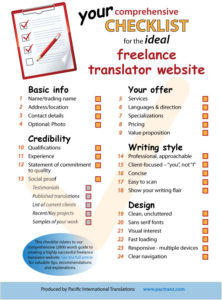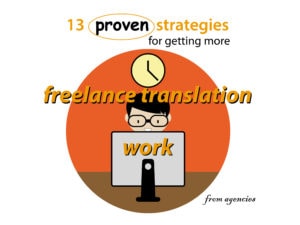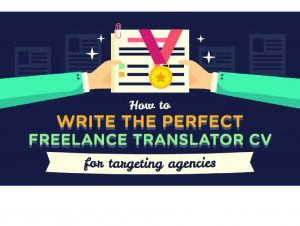What’s the test of a great freelance translator website?
How about that it does a great job at converting visitors into clients.
That means a site that so impresses your potential clients they’ll happily place their translation work with you.
So how do you do that? Well you need to get everything right and do a superb job at establishing your credibility.
If that sounds a bit daunting, then this article is for you. We’re going to step you through exactly what your freelance translator website needs to achieve precisely that.
We’ll cover:
– the content you need
– the focus and writing style to adopt
– key web design elements to get right,
and provide a bunch of key credibility-building tips throughout.
All topped off with a comprehensive checklist you can download to assess and improve your site.
Let’s dive right into it.
Or our slide show:
Building credibility – the four areas of content your freelance translator website must get right
When prospective clients click through to your website, what are they looking for?
On one level, basic information – who you are, if you offer the freelance services they want, how to contact you, maybe your pricing.
But on another, maybe even subconscious, level, they’re also wanting:
Confirmation you’ll do a good job and be easy to deal with.
And let’s be honest, if they don’t quickly get the impression you’re a great translator and will do a great job on their work …
poof! They’ll be gone in seconds, never to return.
So your freelance translator website needs to give them exactly that.
Which means not just building your site with your clients in mind, but creating it for them.
To do that, you need to cover at least the who, what, why, and how of your service:
- who you are
- what you can do for your clients
- why they should use you
- how to proceed from here
Let’s look at how to get maximum advantage from each of these.
1. Who you are
First up clients must be totally clear who they’ll be dealing with.
That means your name of course, an address (or at least your location) and clear contact details.
If you use a trading name, make sure you spell out that it’s you who is behind that name:
“Wonderful Translations is the trading name of Wanda Fewell. I am …”
Consider using a (professional) photo – an image presenting you as open and approachable will suggest you’ll be easy to deal with, something every client wants.
Mistakes to avoid
When starting out in business it’s easy to feel you need to act super professional and pretend you’re a (big) translation company, but that’s really not the case.
Here’s why:
Sure, some clients only want to deal with companies. They don’t want the perceived risk that a freelance translator will fall under a bus or stop operating for whatever reason and leave them in the lurch. They think it’s easier and safer to deal with a bigger outfit.
But other clients much prefer to deal with individuals. They think they’re likely to get a more personalised and speedy service, and better value for money.
As a freelancer there’s no point trying to pretend you’re a company to attract the first type of client. Instead, celebrate the fact you’re a freelance translator, and go for the second type – they’re the perfect match for you.
So, don’t:
- pretend you’re a bigger operation than you are
- use “we” instead of “I” when it’s just you
- hide behind a trading name and not identify who you are
- confuse clients by mixing “we” and “I”
Clients demand transparency and honesty and any of these errors will kill your credibility stone dead.
2. What you can do for your clients
At a basic level this means defining your:
- services (translation, editing, etc)
- languages
- direction(s)
- specialisation
Don’t:
Claim you specialise in a long list of technical fields.
It simply looks unlikely, and if potential clients think you’re pretending to be something you’re not they’ll be gone in a flash.
Don’t do it!
On another level, it’s about marketing yourself.
Most freelance translators will simply list the features of their services, but what clients really want to hear is how you’ll make their life easier.
Maybe how you’ll:
- save them work or time
- make the process easier
- solve their issues
- be real easy to do business with.
Plus of course, all clients are also looking for peace of mind you’ll do a top quality job.
So, look at things from your clients’ point of view and try to get a handle on what they’ll really value beyond just getting their materials translated. Then write your content to show that’s exactly what you’ll give them.
In marketing terms this is your value proposition – the value/benefit your clients will get from using your services.
3. Why your clients should engage your services
Essentially you want your website to demonstrate you’re brilliant!
More accurately, it’s about convincing potential clients you’ll do a great job and are the ideal person for their translation work. Which means showing them:
- you have the skills to do the work (you’re a true pro)
- others think you’re great (you have a proven track record).
Proof you’re a genuine professional translator
Listing your qualifications and experience will immediately show you’re a professionally trained and accomplished translator, not an amateur or wannabe. Don’t go into much detail though (clients are always in a hurry), just give a clear and concise description.
Make sure to mention your membership of translation and interpreting and other professional associations – showing you’re an active member of your professional community is a great way to add credibility.
Our tip:
Consider adding a statement of your commitment to high quality and professional standards. But I wouldn’t leave it at that – after all pretty much everyone says the same thing, and it can seem very hollow to a client.
I’d explain how you do that – the translation process you use, colleague peer review, etc. Providing some evidence to support the statement will make it far more convincing.
Social Proof
It’s a simple fact that clients will take infinitely more notice of what others say about us and our translations than anything we might have to say ourselves.
Just like we might check guest reviews before booking a hotel – we’ve all learnt to be wary of what people say about themselves.
Which for me makes this the most important section of your website – the single biggest factor that’ll establish your credibility as a translator and convince your clients to use your services.
Here are 5 great ways for your website to provide social proof that others value your freelance translation work:
Client Testimonials
There’s simply no better evidence of your quality than satisfied clients singing your praises. And potential clients will place huge store on this.
So include a section with a few judicious quotes from existing clients – they’ll be a powerful convincer.
And here’s the best part:
Not only are client testimonials one of the most effective forms of marketing, but you can get them very easily! See the dead simple but highly effective method we use.
Published translations
Clients will look at work you’ve had published as proof others have faith in you, with the implication being you must therefore be a good translator and they can trust you too. So it’s great social proof.
And don’t think just books and e-publications here – articles and reports you’ve translated and even meaty website content can be just as persuasive.
Have links to where they’re published, with thumbnails where available. Just make sure that if something isn’t in the public domain, you have your client’s permission to use it this way.
List of current clients
Again, potential clients are going to think “if all these other companies use you, you must be good”.
However two cautions:
- You probably need brands your potential clients will recognise – if they’ve never heard of these companies they may think “so what?”, or worse “so how come you don’t do work for any big clients?”
- A lengthy list of company names or series of company logos with no accompanying explanations or detail can be unconvincing and may even look contrived.
So make sure to include explanations/descriptions of the work you’ve done and maybe when, with samples and links where possible.
And of course if you can sprinkle a few testimonial comments through your descriptions, that’ll be even more powerful.
Recent or key translation projects
A list of significant projects has a similar effect – “you’ve translated a lot of important stuff, so you must be good”.
Again though, a bare list won’t convey very much, so you need to add sufficient information to demonstrate the scale and/or importance of each project.
And include examples, links and testimonials where you can.
Samples of your work
On their own, samples are probably less effective than the other four strategies.
That’s because you’re not providing anything to show those sample translations are actually of high quality.
To confirm your translating ability a client would have to get them checked out, and few will want to go to that trouble.
That’s why what others say and hinting at others’ confidence in your work carries so much more weight.
Still, if none of the other options are open to you, samples are certainly better than nothing. Just remember to get client permissions where necessary.
4. How to proceed
You must be easy to contact, through whatever means you make available on your site. And the more options you provide the merrier – it lets clients choose what’s most convenient for them, and makes them more likely to make the step of contacting you.
I’m amazed how many freelancers don’t provide a phone contact on their website, or if they do, don’t ever answer it. Some things are so much easier working through on the phone than getting bogged down in complex e-mail exchanges.
Plus, certain clients favour verbal contact over e-mails – not being able to speak to you will frustrate them (and possibly drive them away).
What about a contact form? Well, many people hate them, so why would you have one?
Whatever you do, don’t make it the only way to contact you. To me that sends a message that you don’t really want to be contacted at all – because we’ve all experienced using forms and never getting a response.
If you do have a contact form on your site, make sure it’s short and very simple to complete, that you respond quickly to it, and you’ve also provided other ways to contact you.
You should spell out how a client can get a quote from you or assign you a job:
“For a no obligation quote, …”
The elephant in the room – what about pricing?
Many freelancer websites don’t discuss pricing at all, but I think you should, for two reasons:
- it’s a key thing your clients want to know. And I’m a great believer in giving clients what they want. Besides, if it’s a key client consideration, doesn’t it seem a bit odd to not even discuss it?
- it shows you’re open and transparent. That’s something clients value highly as it’s a good indicator you’re likely to be easy to do business with – straight up and unlikely to complicate things. So another subconscious tick that you’ll be the right translator for their work.
Some freelancers will be happy to quote their translation rates on their websites, but if you’re not in that camp, here are our tips on what to do.
- Give a range, with explanations of what will affect them – subject matter, time frame, projected use, etc
- Explain where your rates sit compared to others – “I’m at the mid range for freelance translators in my language, and highly competitive compared to translation companies that offer similar quality”
- Identify the factors that govern your pricing, and say that because every project is different you prefer to quote for each one
Whatever you do, be sure to say you’re always happy to provide a quote – and make it quick and easy for them to get one from you.
Win over your clients with the right focus and writing style
We’ve said your website should be written for your clients, to give them what they want.
This has implications for how you write your content, and I’d recommend the following:
Try to use “You” rather than “I”
Compare these two sentences:
“I’m committed to producing translations of the highest standard. I … “
“You can be assured your translations will be of the highest standard. Your text will be … “
Same concept, different focus. The second version directly engages your client, the first doesn’t; the first is impersonal, the second shows empathy.
Clients will automatically respond better to a “you” focus.
They’ll subconsciously assume you see things from their point of view, so they’ll think you’re likely to look after their interests and give good service. Which is exactly the sort of translator they want!
It’s a good idea to review all your website content to see that it has a clear client focus.
A dearth of the pronoun “you” and an abundance of “I” should prompt you to re-work some passages. It will result in a much more effective site.
Cater to clients in a hurry
Like all of us, clients typically want information fast. I mean FAST!
So make it easy for them to get what they want on your site, FAST.
You can do that by:
- Making your pages easy to scan/skim – through clear headings and subheadings, short sentences & paragraphs, bullet points, etc
- Putting the key message in a passage up front, with explanations and further detail following. Ie the opposite to an essay where you build to a conclusion.
- Writing concisely – short sentences, short paragraphs, short sections
Other tips on style
- Adopt a professional, engaging and approachable writing style
- You’re a wordsmith and earn a living through your writing talents. So showcase your command of the language and writing flair by sprinkling some well-crafted phraseology and higher register vocabulary through your short and concise text.
- Go cautious on the hype – clients seldom like spin or fluff, and too much will put them off, big time
Highlight your professionalism through attractive design
To generate the impact you’re after, your website design has to do 2 things:
- look professional (be appealing), and
- be a good user experience (not put anyone off)
So here’s a short list of things to make sure you get right:
Visual appeal
- Ensure a clean, decluttered look to your pages. Ie, have plenty of white space.
- Use sans serif fonts such as Arial and Verdana rather than serif like Times. And have larger point sizes
- Create interest on the page with bolding, colour, relevant images, bullet points.
User experience
- Nail fast page load times – clients will disappear real fast if they have to wait
- Ensure your site looks good on mobile devices
- Have clear navigation so it’s easy move around the site and take action
Putting it all together – your checklist
Use our free checklist to assess your site,
or guide you in creating one.
Putting it all together – a possible freelance translator website page structure
For most freelance translators, a 4 to 6 page website structure like the following should do the trick.
Home – who you are, what you offer (languages, services, specialisations), where you’re located.
About me – translation qualifications and experience, professional memberships
Services – additional detail to your home page information
Why choose me? Your commitment to quality, social proof (testimonials/publications/projects/clients/samples)
Pricing/quotes – rates or pricing statement, how to get a quote/quote form
Contact – address, ways to contact you
Where content is thin, you can combine sections into fewer pages.
Other content you may wish to consider:
Blog
You should only include a blog on your site if it is completely professional and will enhance and not detract from your professional image. A business website is no place for your personal blog, so use a different forum for that.
A blog should have a secondary role on your website, with the main focus being your existing and potential business clients.
Make it the last item in your menu list.
Privacy policy, terms of trade
The rationale for adding these is they can be seen to add legitimacy to your site – giving the impression you’re a well established, successful business.
If you do include them, I’d recommend writing them in plain language. A zillion clauses of legalese strikes me as being decidedly client unfriendly, whereas plain language is not only easier for clients to understand but hints you communicate well and will be easy to deal with. And that has to be a good thing!
Check out our terms of trade for ideas.
Wrap up
The keys to creating a commercially successful freelance translator website are:
- writing it for your clients
- having the right content
- demonstrating your credibility
Following the guidelines presented here will enable you to do precisely that.
Which should see you converting more of your visitors (potential clients) into active clients.
Want some help on the technical side of creating your website? We recommend this comprehensive tutorial from Petrucio Translation.
They’re there to help you with the practical side of being a freelance translator.You’ll find practical tips for your cv, setting your rates, dealing with agencies, quoting and a whole lot more.
Check them out on our translator tips and resources page.
Or you might want to start with one of these:
13 proven strategies for getting more freelance translation work from agencies
How to write the perfect translator CV for targeting agencies
The proven, dead simple way to get great client testimonials










